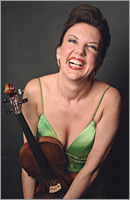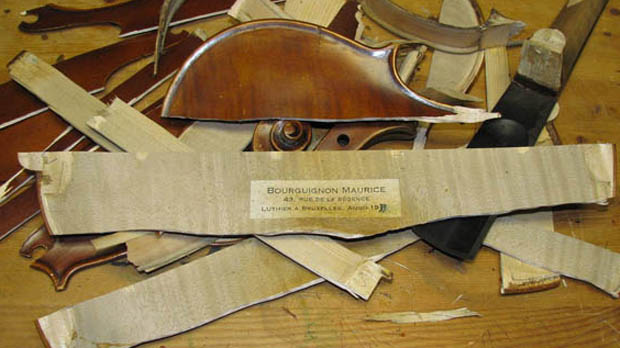One of the participants in the controversial Indiannapolis test of Stradivarius and modern violins has broken cover to offer a personal view of how the tests were conducted and how his perception of the sound of violins was changed. His essay is published exclusively on Slipped Disc for the benefit of violin professionals who want to read the story without newspaper and internet hype.
UPDATE: Beneath John’s report, I’ve added a link to accounts by the editors of Strad magazine and violin.com, both of whom also took part.
The Old/New Violin Trial – One Insider’s View
John Soloninka, Toronto, Canada.
I was one of the 21 violinists in the hotly-debated “old vs new” violin experiment run by scientist Claudia Fritz and luthier Joseph Curtain at the 2010 IVCI in Indianapolis. It was fascinating – but so too is the debate triggered by release of the results. The double-blinded, scientifically-run experiment showed that “expert” violinists could not tell whether an instrument was new, or by an “old master”. In addition, of the 3 high-quality new instruments, valued collectively at $100K and 3 venerated old master instruments valued at about $10M, the widely preferred instrument was a new one, and the least, a Stradivarius. These findings are consistent with many past comparisons, but this is perhaps the most scientifically rigorous experiment to-date. As an accomplished amateur violinist and violin maker, I wanted to give you both an insider’s view of the experience, and address some of the questions posted on the many blogs and internet sites.
My participation was serendipitous: my wife and I were audience members at the IVCI competition, and spending time at the violinmakers’ display running jointly with the competition. I had known Joseph Curtin and many other of the world’s best violin makers from overlapping music and violin-making conferences/workshops over the years. 
When discussing the violins on display, I lamented to Joseph that I had played several $300K-$1M instruments, but never a Guarnerius…he jumped at the chance to sign me up, along with 20 others (IVCI competitors, judges, symphony musicians and people like me) to take part in the formal experiment that next day.
On the walk over to the hotel, I told Claudia Fritz, the lead of the study, of my experience of a few years earlier: Michael Darnton, a violin maker and expert at the famous Bein and Fushi in Chicago, home of the Stradivarius Society, laid out 8 anonymous, old and new violins in a practice room for me, ranging in price from $10K up to $350K. I proceeded over the next hour or so to play them, arranging them in “quality” (price really), being careful not to look at the labels. A friend wrote down my impressions of tone, projection, colors, response etc. Of course I couldn’t help but see the outside of the violins. Given the price range, there was also wide range of playing quality of the instruments. According to Michael, my eventual rank ordering was spot on, with a modern instrument at the bottom, and an old master “Goffriller” at the top. Even though it was unscientific, the result seemed obvious to me!

So we arrive at the hotel room and get administrative and waiver stuff out of the way (the rest of the experiment and setup is well described in the PNAS paper by Fritz, Curtain et al, and I won’t repeat it here). I concocted my method of assessment as I walked over the hotel: opening of the Bruch G minor and Tchaikovsky concerti, sampling low to high registers; Barber concerto opening…lyrical mid range up to high registers; Paganini Moto Perpetuo… measuring response, and Tchaikovsky 2nd movement to test high on the D string…with some solo polyphonic Bach, mixed scales and open strings. I tried to do this identically with all instruments. (Knowing I was handling $10M in instruments was a pretty heady experience!) And the results? I loved all of the instruments. Some were more or less to my liking, but all were wonderful. I had NO ability to tell which instruments were old or new.
I expected old instruments would have greater purity and richness of sound, greater range of tonal “color”, little extraneous “surface noise”, effortless/rapid response, and projection ranging from good to great. I expected new instruments to range from ordinary to “loud”, but to be a bit less responsive to the bow (taking just slightly longer time to create quality sound from any given bow gesture, requiring more “work” from the player), to have more “rustle” and surface noise (perceptible perhaps only to the player…but perhaps imperceptible from an audience’s perspective) and perhaps to have less complex of an overtone structure (i.e. “flatter sound”). Also, I expected the old instruments, on average, to be physically lighter weight, as many newer instruments made with acoustic tuning methods that can tend to heavier plates, and use younger, less desiccated wood.
I was completely wrong. I experienced my anticipated “old instrument” characteristics on almost all of the instruments. Only one I considered “weak, easy to break the sound” and having less than high quality tone (that was a Strad!!!!!). My favourite was a new one, New2, and it played exactly as I had “expected” a Guarnerius Del Gesu would have played…powerful, difficult to “overplay”, complex, highly responsive, and joy from the moment I picked it up (but so were virtually all of them).

From the transcripts Claudia sent me, here are some or my amusing comments at the time. Remember I did not know which instruments were which. I have denoted after the fact the instruments New1-3 and Strad1, GdG and Strad 3 as the old Masters:
- “[I think] New2 is old and GdG is new. I told you on the way that I could tell whether old or new … actually I can’t tell at all!”
- “Strad1: dramatic difference between the A-string which has a muted sound and the D-string which has a bold sound. The G is also bold but it has a bit of rustle.
- “New1: feels like a new instrument. High up on the D (notes B & C) don’t have a crystalline/penetrating quality. Complex sound but not clear.”
- “ New2 is definitely the one I’d take home. It feels like it would really project at the back of a hall. It’s a good complex quality of sound. No dead spots. It’s a style of sound which suits me. Big powerful G. You don’t drop a few dB as you go across the strings.”
- “Strad1: I don’t like it. I don’t feel like it will project in a hall. Not a bad sound but a bit nasal. Sounds like a French instrument, from 1800-1840.”
Some have criticized the choice of a hotel room rather than a concert hall. This is a good point, but in fact was addressed informally. Zack DePuy, Concertmaster of the Symphony also did side-by-side comparisons of 8 new and old instruments on stage before the final announcements were made for the IVCI. Although a Strad was eventually chosen, in short, the audience in the concert hall had only slight leanings on which instrument was better in each of the pair-wise instrument comparisons…with Zack playing the same excerpts from Ein Heldenleben and Bruch G minor. Listening to Zack…I could tell slight differences in the instruments…but overall they were all great. None of them sounded substantially weaker than the others.
Many internet commenters quote expert violinists who claim old instruments are superior. Are they delusional? No, not in that they lack a sense of what quality sound is, or the dynamics of what a good instrument is. But endless psychological research shows that 1) people’s subjective impressions of violin sound, wine, etc are highly unreliable and unrepeatable over time, and 2) people are overwhelmingly influenced by knowledge or impressions of what they are testing. Note in the Fritz study, that the same pairs of instruments were unknowlingly and repeatedly tested by each player….and players were not consistent in their evaluation of them, on the same day, in the same room. This is why double blind studies are the only true test. Of course those earlier quoted “experts” chose old instruments….this is “cognitive dissonance” at work…they want or believe the old masters to be the best.

Some have commented that the projection and frequency distribution of “good” instruments are able to fill a room and “bad” instruments not. This is very true and can be show experimentally that different regions of the sound spectra get less degraded than others in real concert halls. But that “good” frequency distribution is not unique to old instruments…as Martin Schleske and others shown in his extensive frequency analysis of good old and new instruments.
I agree with others’ comments that these were instruments by the best modern makers…and not all new violins are by the best makers, and not all new or old instruments are the best examples from those makers! It is not hard at all to tell a cheap instrument from a great instrument. But the goal of this test was just to say that the best modern makers are as good as the best old makers…and that sound, not age, is what counts.
The whole point is not that fine old violins aren’t great…but rather, that from a sound perspective, brand new violins from the finest makes are just as good, and in many cases better. People may pay millions for a Chippendale or Louis IV furniture…or Rembrandts (or Rothkos!!!).

In those cases….AND in the case of Strads, the sound is NOT a factor in setting the price. It is history, provenance etc. This experiment is just more proof that the price is NOT related to sound.
It was a privilege to be involved and fascinating. If, after this, you cling to picayune critiques and dismiss the study, then I think you are in denial. If 21 experienced players could not tell old from new in controlled circumstances, and an entire audience could not hear material differences in a hall…and this is consistent with past studies…then it is time to put the myths out to pasture.
UPDATE: The editor’s tale… here are reports fromLaurie Niles and Ariane Todes





